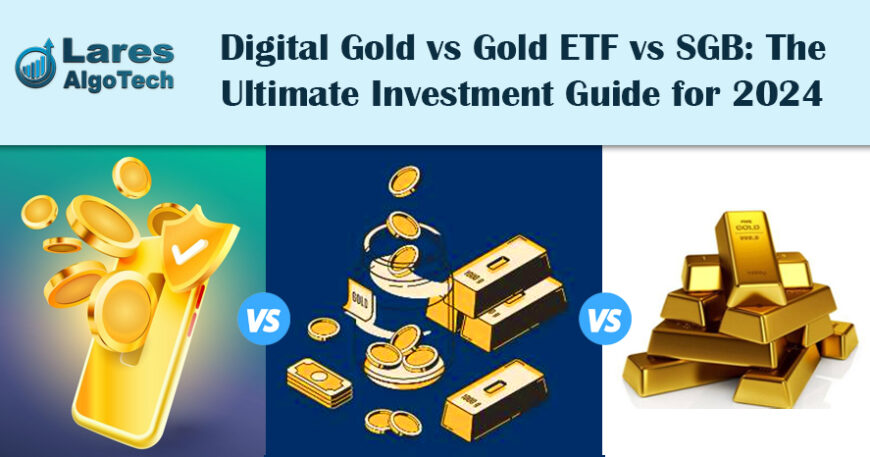Gold has been a trusted store of value for centuries, a symbol of wealth and a hedge against economic instability. In 2024, gold remains a popular investment option, but the methods of investing in gold have evolved. Traditional gold bullion has been joined by modern alternatives like Digital Gold, Gold ETFs (Exchange-Traded Funds), and Sovereign Gold Bonds (SGBs). This guide delves into these three popular investment avenues, comparing their features, benefits, and drawbacks to help you make an informed decision.
Digital Gold
What is Digital Gold?
Digital Gold is a modern way of investing in gold. Investors can buy, sell, and store gold online without worrying about physical storage. The purchased gold is backed by physical gold stored in secure vaults.
Benefits of Digital Gold:
- Convenience: Buying and selling Digital Gold is as easy as a few clicks. You can transact anytime, anywhere.
- Affordability: You can start investing with a small amount, as low as INR 1, which makes it accessible to a wider audience.
- Liquidity: Digital Gold offers high liquidity. You can sell your holdings at any time, with the proceeds credited directly to your bank account.
- No Storage Issues: The gold is stored in insured vaults, removing the risk and cost associated with physical storage.
Drawbacks of Digital Gold:
- Charges: There may be charges for buying, selling, and storing Digital Gold, which can eat into your returns.
- Regulatory Risks: Digital Gold is not regulated by any central authority, posing potential risks if the company holding the gold faces financial difficulties.
- No Interest: Unlike SGBs, Digital Gold does not provide any interest income.
Gold ETFs
What are Gold ETFs?
Gold ETFs are exchange-traded funds that invest in gold bullion. Each unit of a Gold ETF represents a specific amount of gold, typically 1 gram. They are traded on stock exchanges, just like shares.
Benefits of Gold ETFs:
- Transparency: Gold ETFs provide transparent pricing as they are traded on stock exchanges.
- Cost-Effective: They usually have lower expense ratios compared to mutual funds and no entry or exit loads.
- Liquidity: Gold ETFs offer high liquidity, allowing investors to buy or sell units on the stock exchange during trading hours.
- No Storage Worries: The gold is stored in secure vaults by the fund, removing the need for personal storage.
- Regulated: Gold ETFs are regulated by the Securities and Exchange Board of India (SEBI), providing a layer of security.
Drawbacks of Gold ETFs:
- Brokerage Fees: Buying and selling Gold ETFs incurs brokerage fees and transaction charges.
- Market Risks: The price of Gold ETFs can be influenced by market demand and supply, sometimes deviating slightly from the actual gold price.
- No Physical Ownership: Unlike physical gold or Digital Gold, you don’t own the actual metal but a paper representation.
Sovereign Gold Bonds (SGBs)
What are Sovereign Gold Bonds?
Sovereign Gold Bonds (SGBs) are government securities issued by the Reserve Bank of India (RBI) on behalf of the Government of India. They are denominated in grams of gold and are a substitute for holding physical gold.
Benefits of SGBs:
- Interest Income: SGBs offer a fixed annual interest rate of 2.5%, payable semi-annually, in addition to the potential price appreciation of gold.
- Tax Benefits: The capital gains tax arising on redemption of SGBs is exempt. Furthermore, there are no TDS (Tax Deducted at Source) implications on the interest earned.
- Security: Backed by the government, SGBs are considered one of the safest investment options.
- No Storage Costs: Like other non-physical gold investments, SGBs do not require storage.
- No Making Charges: Unlike physical gold, SGBs do not incur making charges, enhancing your investment’s value.
Drawbacks of SGBs:
- Lock-In Period: SGBs come with an 8-year tenure, with an option to exit after the 5th year. This lock-in period can limit liquidity.
- Liquidity: Although SGBs can be traded on stock exchanges, the trading volumes are typically low, which can make it challenging to sell large quantities quickly.
- Interest Rate Risk: While the fixed interest is a benefit, it might be less attractive if market interest rates rise significantly.
Comparison
-
Investment Horizon:
- Digital Gold: Suitable for short to medium-term investments due to its high liquidity.
- Gold ETFs: Ideal for medium to long-term investors looking for a balance of liquidity and potential returns.
- SGBs: Best for long-term investors who can commit to the 5 to 8-year tenure.
-
Liquidity:
- Digital Gold: Highly liquid, with easy buy/sell options.
- Gold ETFs: Liquid, but subject to market trading hours and volumes.
- SGBs: Limited liquidity due to the lock-in period, with trading on exchanges not always offering immediate sale options.
-
Costs and Charges:
- Digital Gold: Potential charges for buying, selling, and storage.
- Gold ETFs: Brokerage fees and expense ratios.
- SGBs: No making charges or annual maintenance costs, but early redemption can incur costs.
-
Returns:
- Digital Gold: Returns based on gold price movements.
- Gold ETFs: Returns based on gold price movements, with slight deviations due to market demand.
- SGBs: Returns based on gold price movements plus a 2.5% annual interest.
-
Taxation:
- Digital Gold: Subject to capital gains tax.
- Gold ETFs: Subject to capital gains tax.
- SGBs: Capital gains tax exempt on redemption; interest income is taxable.
Which is Best for You?
-
Risk Tolerance:
- Low Risk: SGBs are the safest option due to government backing.
- Moderate Risk: Gold ETFs offer regulated exposure with moderate risk.
- Higher Risk: Digital Gold, being less regulated, carries a higher risk.
-
Investment Goals:
- Short-Term Goals: Digital Gold is preferable for its liquidity and ease of access.
- Medium-Term Goals: Gold ETFs offer a good balance of liquidity and potential returns.
- Long-Term Goals: SGBs are ideal for long-term wealth preservation and growth, with added interest income.
-
Convenience and Flexibility:
- Digital Gold: Highly convenient with instant transactions.
- Gold ETFs: Convenient but subject to market hours.
- SGBs: Less flexible due to the lock-in period.
Each gold investment option—Digital Gold, Gold ETFs, and Sovereign Gold Bonds—has unique features, benefits, and drawbacks. Your choice should align with your investment horizon, risk tolerance, liquidity needs, and financial goals. Digital Gold offers convenience and flexibility, making it suitable for short-term investors. Gold ETFs balance liquidity and regulated investment, ideal for medium-term investors. SGBs, with their government backing and interest income, are perfect for long-term investors looking for security and stable returns.
By understanding these options, you can make a well-informed decision and tailor your investment strategy to maximize returns while managing risk in 2024. Happy investing!





 .facebook.com/lares.algotech
.facebook.com/lares.algotech  instagram.com/laresalgotech/
instagram.com/laresalgotech/  x.com/AlgoLares
x.com/AlgoLares  whatsapp.com/channel/...
whatsapp.com/channel/...  .linkedin.com/company/lares-algotech/
.linkedin.com/company/lares-algotech/  youtube.com/@LaresAlgoTech
youtube.com/@LaresAlgoTech